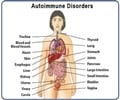Discover how identifying biomarkers can help to predict disability progression in multiple sclerosis (MS).

Strategies to mitigate infection risks in MS therapies
Go to source).
‘Did you know? Researchers have identified biomarkers that can predict worsening disability in multiple sclerosis.’





Additionally, they found that serum glial fibrillary acidic protein (sGFAP) levels, which increase in the bloodstream due to central nervous system (CNS) injury or inflammation, are linked to PIRA in patients with low sNfL levels.Critical Biomarkers for Multiple Sclerosis Identified
The researchers analyzed blood samples from 725 MS patients that were taken within a year of the disease’s onset for the study. Researchers evaluated the predictive usefulness of sNfL and sGFAP levels to predict RAW and PIRA using the Single Molecule Array (SIMOA) technology.Important discoveries reveal a connection between elevated sNfL levels, a marker of acute inflammation in the central nervous system in multiple sclerosis, and a 45 percent higher risk of RAW and a 43 percent higher risk of PIRA.
High-efficacy disease-modifying therapies (HE-DMTs), such as natalizumab, alemtuzumab, ocrelizumab, ritaximab, and ofatumumab, demonstrated notable improvements for patients with elevated sNfL levels who frequently did not respond well to conventional DMTs.
Conversely, patients exhibiting high levels of serum glial fibrillary acidic protein (sGFAP), which reflects localized inflammation caused by microglia in the central nervous system (CNS), faced an 86% increased risk of progression independent of relapse activity (PIRA).
Advertisement
Multiple Sclerosis Management Based on Biomarker Levels
Interestingly, while sGFAP is known to be associated with progression, high sNfL levels limited the ability of sGFAP to predict this outcome. Specifically, sGFAP values were predictive of PIRA only in patients with low sNfL levels.Advertisement
Patients with low levels of both biomarkers had a good prognosis and could be treated with injectable or oral DMTs. However, high sNfL levels indicate a need for HE-DMTs to prevent disability worsening, while patients with high sGFAP levels and low values of sNfL may require new therapeutic approaches.
These distinct pathways in MS have significant therapeutic implications, as current DMTs primarily target the peripheral adaptive immune system without affecting CNS immunity. Therefore, identifying patients with higher levels of peripheral inflammation is crucial for preventing disability and improving patient outcomes.
“The results of this study underscore the critical need for personalised treatment approaches to effectively manage the millions of people affected by MS worldwide, many of whom have a chronic disability that significantly impacts their quality of life,” says Dr. Monreal.
“By measuring both sNfL and sGFAP levels at disease onset, we gain valuable insights into the progression pathways of MS, enabling clinicians to identify the optimal patients for specific DMTs. This approach aims to prevent disability while avoiding unnecessary treatment-related risks for those at lower risk."
Reference:
- Strategies to mitigate infection risks in MS therapies - (https:ectrims.eu/ectrims-spotlight-september-2024)
Source-Eurekalert













